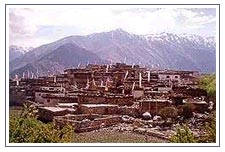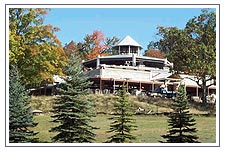
Landlocked
behind formidable mountain barriers in the western Himalayas, sheltered from
the rain-bearing monsoon winds, the remote and desolate district of
Lahaul-Spiti in Himachal is renowned not only for some of the wild, untamed
and enchanting mountain scapes but also for its unique Buddhist culture.
Covering a total area of over 12,000-sq-kms, Lahaul-Spiti is the largest
district of Himachal Pradesh. It shares a common border with Tibet in the
east. A lofty offshoot of the great Himalayan range in the southeast
separates it from Kinnaur. In the north, the Baralacha range separates it
from the cold desert of Ladakh, while the Chamba and Kullu district lie to
the west respectively.
Lahaul's only link to the outside world is by a road, which runs over
the 3,980 m high Rohtang Pass. Lahaul is separated from Spiti by a high
mountain range running towards the north from the great Himalayan range. A
treacherous road over the Kunzam Pass connects the two valleys. Another road
from Kinnaur links Spiti to the Hindustan-Tibet road.
Withstanding The Harsh Environ
Enmeshed in the folds of the great
Himalayas, the climate is cold and arid, with very little rainfall. The
topography, therefore, consists of dry, dusty desolate mountains, virtually
devoid of vegetation spread endlessly in all directions like a moonscape,
resembling Ladakh and Tibet. The monotony of this stark, haunting russet
landscape is broken only by shades of green along the cultivated river
valley.
Sculpted by the wind and moulded alternately by freezing cold and searing
heat, the landscape of this frontier district has evolved a distinctive
profile. Steep towering cliffs of hard rocks rise up into the perpetual
azure sky all around, their slopes covered with heaps of weathered rocks. At
the centre, the rivers have played their part, cutting deeper and deeper
creating fertile banks. Few parts of the Himalayas can compare with Lahaul
Spiti for sheer grandeur. And splendour of the mountains, for here nature
holds sway in its wildest and grandest manner.
Bearers Of A Historic Cultural Heritage

Marked
by high mountains, bleak rugged topography and a harsh climate, the cultural
landscape of this Himalayan borderland is characterised by a unique blend of
two adjacent cultures. The Sino-Tibetan in the north and the Indian culture
in the 7th century AD and with the passage of time it became the major
religion of Lahaul-Spiti.
Today the district is studded with numerous Buddhist temples and
monasteries including Labarang, Gondhala, Dalung, Keylong, Guru-Ganthal,
Darcha, Markula in Lahul and Dhankar, Mud, Lidang, Rangrik, Ki (also spelt
as Kye), Losar and Tabo in Spiti. A millennium old Tabo is one of the area's
most revered monasteries. Often called the "Ajanta of the Himalaya"
because of its breathtaking murals and stucco images, tabo's sanctity
in trans-himalayan buddhism is next only to tibet's tholing gompa.
Apart from their religious influence the monasteries are also strongholds
of tradition and treasuries of the region's art and manuscripts.
Gompas, forts and chorten scattered all over the vastness of this cold
desert provide an unending feast for the sightseer and for scholars, some
authentic foot-notes and references to the local history and culture.
The Lahaul district of Himachal is one rare pocket in the Indian Himalayas
where one may trace a continuous course of development of Trans-Himalayan
Buddhism and it is probably one of the last remaining areas in which the
original Tibetan-Buddhist culture remains untouched either by communism as
in tibet, or by the dissolving influence of tourism to which ladakh has been
exposed.
The
traditional economy of this tribal belt was based on agriculture, sheep
rearing and trade. The subsistence economy and culture evolved in response
to the hostile environment. However with massive developmental works such as
road construction, modern agriculture and horticulture, Government services
alongwith the presence of a large number of "outsiders", armed
forces, traders, government servants and road workers has altered the
traditional way of life.
Changes have occurred in dress patterns, food habits; traditional
occupations like sheep rearing and even in the religious life. Although
change is inevitable and no community wishes to preserve itself as a museum
of backwardness, it is the rapid pace of change and a lack of understanding
of the nature of change, which a society is unable to control, or direct
that touches a cord of concern. The development of tourism accelerates this
process of change and rapidly pushes traditional societies into the global
economy totally ill-equipped.
Promoting Tourism

Ladakh
was opened to tourism in the early 1970s without making any adequate
preparation and ensuring safeguards. Since then, uncontrolled tourism has
transformed Ladakh from a traditional to a typical tourist destination and
many see western culture swamping the Ladakhi way of life. Today, the
self-sufficient Ladakhi economy has undergone a massive and dramatic shift
to one, which is dependent on the outside.
However, unlike Ladakh where uncontrolled tourism has disturbed the
delicate ecological balance and brought drastic socio-cultural changes,
Lahaul-Spiti is yet to face the full force of tourism. Tourism, if
successfully managed, can contribute to the ability of the tribal people of
this district to control and direct the change they are undergoing. Tourism
development, poverty alleviation, awareness generation and strengthen the
self-sufficient economy. This is the key to turning tourism's impacts
from a burden into lasting sources of benefit. Isolated for centuries due to
the inaccessible terrain and inhospitable climate this region is fragile,
hence adequate safeguards need to be taken to protect this tribal belt from
the adverse influence of tourism.
Such fragile areas should be open only to a very limited number of high
spending tourists with proper regulatory control as is being done by Bhutan.
Inspite of the large foreign exchange earnings that tourism brings, the
Bhutanese government has been far-sighted enough to consider the hidden cost
of tourism to its environment and culture by strictly controlling the number
and the movement of tourists in the country. With only two entry points into
the district, the government can easily restrict the number of tourists to
the carrying capacity of the fragile environment. This, of course, is not a
very fashionable decision to take but it does place the interest of the
local people and their environment before short-term and cost-laden profits.
Tourism is only commencing in Lahaul-Spiti. The government therefore needs
to finely tune the tourism industry to the local culture and the
environment. The vulnerable nature of tourism to unstable political, social
and economic conditions and seasonal nature of tourism dominant in the
mountains should be overcome by efficiently planning the tourism
infrastructure to make it multifunctional.
In fact tourism development must be integrated with the overall development
of the region and the local people should be invited to participate in
tourism right from the planning stage. It is also necessary to ensure some
incentives to the locals from tourism. Environmental considerations must be
integral in development of tourism in this region. Great care needs to be
exercised to conserve the local culture, which is its greatest asset.
By planning and promoting a healthy, sustainable, tourism industry in this
cold desert district, the government will have fulfilled its share of
responsibility but in the end, it may not be the number of tourists but
their sensitivity towards the local culture and environment that will
determine the complexion of tourism and the future of this unique heritage.


 Landlocked
behind formidable mountain barriers in the western Himalayas, sheltered from
the rain-bearing monsoon winds, the remote and desolate district of
Lahaul-Spiti in Himachal is renowned not only for some of the wild, untamed
and enchanting mountain scapes but also for its unique Buddhist culture.
Landlocked
behind formidable mountain barriers in the western Himalayas, sheltered from
the rain-bearing monsoon winds, the remote and desolate district of
Lahaul-Spiti in Himachal is renowned not only for some of the wild, untamed
and enchanting mountain scapes but also for its unique Buddhist culture. Marked
by high mountains, bleak rugged topography and a harsh climate, the cultural
landscape of this Himalayan borderland is characterised by a unique blend of
two adjacent cultures. The Sino-Tibetan in the north and the Indian culture
in the 7th century AD and with the passage of time it became the major
religion of Lahaul-Spiti.
Marked
by high mountains, bleak rugged topography and a harsh climate, the cultural
landscape of this Himalayan borderland is characterised by a unique blend of
two adjacent cultures. The Sino-Tibetan in the north and the Indian culture
in the 7th century AD and with the passage of time it became the major
religion of Lahaul-Spiti.  Ladakh
was opened to tourism in the early 1970s without making any adequate
preparation and ensuring safeguards. Since then, uncontrolled tourism has
transformed Ladakh from a traditional to a typical tourist destination and
many see western culture swamping the Ladakhi way of life. Today, the
self-sufficient Ladakhi economy has undergone a massive and dramatic shift
to one, which is dependent on the outside.
Ladakh
was opened to tourism in the early 1970s without making any adequate
preparation and ensuring safeguards. Since then, uncontrolled tourism has
transformed Ladakh from a traditional to a typical tourist destination and
many see western culture swamping the Ladakhi way of life. Today, the
self-sufficient Ladakhi economy has undergone a massive and dramatic shift
to one, which is dependent on the outside.